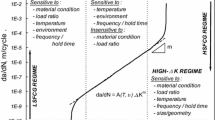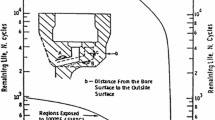Abstract
An experimental study of creep-fatigue crack growth behavior of 1.25Cr-0.5Mo steel at 538°C (1000°F) under trapezoidal loading waveshapes has been carried out on compact type specimens. In creep-fatigue crack growth experiments, hold times ranged from 0 seconds to 24 hours with intermediate conditions of 10 seconds, 98 seconds, 10 minutes and 15 minutes. Time-dependent crack growth rate during the hold period, (da/dt)avg, is correlated with (C t )avg. The values of (C t )avg are estimated using the equation recently proposed for elastic-cyclic plastic-secondary creeping (EL-CPL-SC) materials. The (da/dt)avg vs. (C t )avg data fall on a single trend which matches with the trend of da/dt vs. C t creep crack growth data for the same material. A model is proposed for predicting both the creep crack growth behavior and the creep-fatigue crack growth behavior. The model is suitable for assessing the residual life and/or the safe inspection intervals of high-temperature components such as steam headers. Transition of crack tip damage patterns from oxidation to creep cavitation across the range of hold times examined is also discussed.
Similar content being viewed by others
References
B.W. Roberts, F.V. Ellis, and R. Viswanathan, in Proceedings of the American Power Conference, Chicago, IL, 22–24 April (1985) 295–301.
A. Saxena and B. Gieseke, in Proceedings of MECAMAT-International Seminar on High Temperature Fracture Mechanisms and Mechanics, Dourdan, France, Vol. III October 1987 19–36.
K.B. Yoon, Characterization of Creep Fatigue Crack Growth Behavior Using the C t Parameter. PhD thesis, the George W. Woodruff School of Mechanical Engineering, Georgia Institute of Technology (June 1990).
A. Saxena, Fatigue of Engineering Materials and Structures 3 (1981) 247–255.
A. Saxena, in Fracture Mechanics: Seventeenth Volume, J.H. Underwood et al. (eds.) ASTM STP 905 (1986) 185–201.
J.L. Bassani, D.E. Hawk and A. Saxena, in Nonlinear Fracture Mechanics: Volume. I-Time Dependent Fracture, A. Saxena et al. (eds.), ASTM STP 995 (1986) 7–26.
A. Saxena, H. Ernst and J.D. Landes, International Journal of Fracture 23 (1983) 245–257.
H. Riedel and J.R. Rice, in Fracture Mechanics: Twelfth Conference, ASTM STP 700 (1980) 112–130.
A. Saxena, R.S. Williams and T.T. Shih, in Fracture Mechanics: Thirteenth Conference, ASTM STP 743 (1981) 86–89.
V.P. Swaminathan, T.T. Shih and A. Saxena, Engineering Fracture Mechanics 16(6) (1982) 827–836.
B. Gieseke and A. Saxena, in Advances in Fracture Research: Proceedings of the Seventh International Conference of Fracture: ICF-7, K. Salama et al. (eds), Pergamon Press (1989) 189–196.
A. Saxena, J. Han and K. Banerji, Journal of Pressure Vessel Technology 110 (1988) 137–146.
H. Riedel and V. Detampel, International Journal of Fracture 33 (1987) 239–262.
V. Kumar, M.D. German and C.F. Shih, An Engineering Approach to Elastic-Plastic Analysis, Technical Report EPRI NP-1931, Electric Power Research Institute (1981).
A. Saxena and J.D. Landes, in Advances in Fracture Research: ICF-6, S.R. Valluri et al. (eds.), Pergamon Press (1984) 3977–3988.
K.B. Yoon, A. Saxena and D.L. McDowell, in Fracture Mechanics: Twenty Second Symposium, ASTM STP (1131) H.A. Ernst et al. (eds.) (1992) 367–392.
A. Saxena and P.K. Liaw, Remaining Life Estimation of Boiler Pressure Parts—Crack Growth Studies. Technical Report, Electric Power Research Institute, EPRI contract RP 2253–7 (1986).
A. Saxena and J. Han, Evaluation of Crack Tip Parameters for Characterizing Crack Growth Behavior in Creeping Material. Technical Report, Fracture and Fatigue Research Lab., Georgia Institute of Technology, ASTM Task Group Report, Joint task group E24.08.07/E24.04.08 (1986).
ASTM Annual Books of Standards, Standard Test Method for Measurement of Fatigue Crack Growth Rates, ASTM Standard E647–88 (1988).
R.L. Foster, New method for COD measurement in fracture testing. Knoxville, Tennessee, presented at Workshop for Advanced Instrumentation for Experiments in Engineering Mechanics (1984).
S. Jani and A. Saxena (1988) unpublished research.
J.R. Haigh, R.P. Skelton and C.E. Richards, Materials Science and Engineering 26 (1976) 167–174.
R.P. Skelton and K.D. Challenger, Materials Science and Engineering 65 (1984) 271–281.
G.J. Neate, Materials Science and Technology 88 (1988) 524–529.
M.B. Cortie and G.G. Garrett, Metallurgical Transactions A: Physical Metallurgy and Material Science 19A (1988) 2979–2987.
N. Birks and G.H. Meier, Introduction to High Temperature Oxidation of Metals, Edward Arnold (1983).
H. Riedel, in Elastic-Plastic Fracture: Second Symposium Volume. I-Inelastic Crack Analysis, ASTM STP 803 (1983) I/505–I/520.
Author information
Authors and Affiliations
Rights and permissions
About this article
Cite this article
Yoon, K.B., Saxena, A. & Liaw, P.K. Characterization of creep-fatigue crack growth behavior under trapezoidal waveshape using C t -parameter. Int J Fract 59, 95–114 (1993). https://doi.org/10.1007/BF00012385
Received:
Accepted:
Issue Date:
DOI: https://doi.org/10.1007/BF00012385




